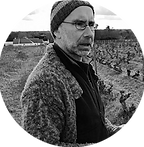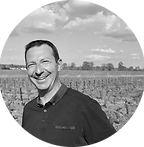Loire


VINCENT BERGERON
Before becoming a Montlouis winegrower, Vincent grew up in the Loir-et-Cher, always close to the Loire River. Today, he and his family are based in Husseau, in the heart of the Montlouis-sur-Loire appellation. His journey into winemaking began in 2012 with Frantz Saumon’s harvest, following diverse experiences. Over five years, he refined his skills before acquiring his first plots in 2017. In 2021, he doubled his vineyard size to 3.5 hectares, increasing both the workload and the joy of crafting wines. His passion and dedication continue to shape his growing domaine and its expressive wines.
Designation(s) :
Grape(s) :

NICOLAS RENARD
Nicolas Renard is a passionate and adventurous winemaker, deeply connected to the land. After working with the National Forestry Organization, he developed a love for plants and turned to viticulture in his native Sarthe. A self-taught vintner, he mastered Chenin while working at renowned Loire estates like Clos Baudouin and Domaine Lemaire-Fournier. His journey took him to Ardèche, where he explored Chardonnay, before settling in Amboise near the Loire. Today, he cultivates Chenin and Chardonnay in Rochecorbon (Vouvray) and Saint-Martin-le-Beau (Montlouis). His wines undergo long aging, crafted with great care and without additives.
Designation(s) :
Grape(s) :

CHATEAU DE LA BONNELIÈRE
It is Pierre, the father of Marc who acquires this magnificent estate in La Roche Clermault on the left bank of the Vienne River in 1976. Pierre replants the vineyard and revives the wine history at Château de la Bonnelière. From the banking sector, Marc began a reconversion and took over the estate in 1999. The evolution towards the organic farming starts at his arrival. Today, Marc grows the vines on a surface of 30 hectares with a typical panel f rapes varieties from the “lands of Francois Rabelais” with Cabernet Franc, Chenin and Sauvignon Blanc.
Designation(s) :
Grape(s) :

JULIEN PREVEL
Julien Prével’s journey is as unique as his wines. Born in Saint-Brieuc, Brittany, he initially pursued history before shifting to winemaking in Montlouis-sur-Loire. In 2010, he trained at the Amboise wine school and apprenticed with Frantz Saumon, who mentored him and supported his transition. He vinified his first bottles in 2012 before officially settling in 2013 at the Moulin Rouge, Stéphane Cossais’ former cellar. A true iconoclast, he remains committed to organic viticulture and natural winemaking—never using inputs. Julien vinifies anything he can, producing an eclectic range of wines and drinks that are always surprising and unforgettable.
Designation(s) :
Grape(s) :

DOMAINE MIKAEL BOUGES
Mikael, in his early 40s, took over his family’s 7-hectare vineyard 15 years ago. The estate is mostly a single plot on a rounded hilltop, with two clos on its northern slope. He primarily cultivates Côt and Sauvignon, along with a small amount of Chenin. Dedicated to organic farming, he avoids chemicals to preserve the land’s natural balance. His approach focuses on expressing the terroir through minimal intervention. With careful vineyard management, he crafts wines that are pure, vibrant, and true to their origin. His commitment to sustainability shapes every aspect of his winemaking.
Designation(s) :
Grape(s) :

DOMAINE DÉSORMIÈRE
Founded in 1974 by Michel and Marie-Jo, this family estate grew with the arrival of their sons, Éric and Thierry, in 1996. Bringing fresh perspectives, they modernized viticulture and winemaking while honoring tradition. Today, the estate spans 16 hectares, cultivating Gamay and Chardonnay. Their focus is on crafting delicate, expressive wines that reflect the terroir. With a commitment to quality, they balance innovation with respect for nature. The family's passion and dedication continue to shape the estate’s identity.
Designation(s) :
Grape(s) :

DOMAINE DE BABLUT
Christophe is the perfect gentleman farmer, crafting wines with a strong sense of terroir. Based in Brissac-Quincé, at the meeting point of Anjou Blanc and Anjou Noir, he combines humility and passion in his winemaking. His vineyards reflect the region’s diversity, allowing him to produce expressive and authentic wines. Committed to sustainability, he works with great respect for nature. His approach balances tradition and innovation to highlight the essence of his land. Each bottle showcases his dedication to quality and terroir-driven expression. Christophe’s wines are a true reflection of his character and expertise.
Designation(s) :
Grape(s) :

DOMAINE DES GUYONS
Frank Bimont’s family has been producing wine since 1634, a legacy he proudly continues. With an oenology background, he took over the 16-hectare estate in 2006. His wines, like him, are delicate, generous, and upright. Committed to precision, he focuses on crafting clean wines with tension and finesse. His philosophy blends tradition with a modern, meticulous approach to winemaking. Every bottle reflects his dedication to purity and elegance. Frank’s wines stand as a testament to centuries of expertise and passion.
Designation(s) :
Grape(s) :

DOMAINE DU PETIT BONDIEU
At Domaine du Petit Bondieu, the Pichet family has been producing wine since 1976. Jean-Marc founded the estate, and his son Thomas took over in 1995. The 18-hectare vineyard, exclusively Cabernet Franc, has been organically farmed since 2010. They focus on a single appellation: Bourgueil, with vines aged 20 to 80 years. The vineyards are planted on diverse soils—gravel, tuffeau stone, and clay-limestone. Their commitment to quality earned them Grower of the Year in the 2017 Hachette guide. Thomas continues the family tradition, crafting expressive and terroir-driven wines.
Designation(s) :
Grape(s) :

CHATEAU DE VEILLOUX
The Quenioux family, originally from Brittany, settled in Fougères-sur-Bièvres in the 16th century. Pierre Quenioux acquired the estate in 1789, and Michel took over in 1975, immediately stopping chemical use. By 1984, Michel fully took charge, certifying the estate organic and introducing biodynamic practices. Today, the estate spans 23 hectares of vines and 140 hectares of cereals, requiring a team of eight. The vineyard includes Sauvignon (10 ha), Orbois (3.8 ha—the world’s largest producer!), Chardonnay, Romorantin, Pinot Noir, Gamay, and Côt. Michel continues his dedication to sustainable and traditional viticulture.
Designation(s) :
Grape(s) :

DOMAINE DE LA ROULETIÈRE
The Gilet dynasty has reigned over the Domaine de la Rouletière for more than ten generations. Jean-Marc was born in 1980, and since 2003 he has been at the helm of this charming estate. Today, this experienced winemaker manages the estate in the same way as his ancestors: as a family. Accompanied by his wife Theodora and his young children; Constance, Camille and Louis, the estate has no less than 26.6 hectares cultivated organically since 2013. Jean-Marc and Théodora like wines that keep freshness and vivacity, and it is with great humility and a lot of generosity that they practice each year to produce wines tattooed with an identity with the imprint of the vintage.
Designation(s) :
Grape(s) :

DOMAINE VALLÉE MORAY
Hervé and his family settled in Montlouis-sur-Loire in the early 2000s. Originally from Charente, he transitioned from a career as a meteorologist to winemaking. A self-taught vintner, he gradually honed his skills and philosophy. In 2016, he vinified his first vintage on 4.5 hectares, with old vines averaging 60-70 years. Chenin dominates with 3.2 hectares, alongside 1 hectare of Pinot Noir and 30 ares of Gamay. Both in the vineyard and cellar, he prioritizes meticulous care and minimal intervention. His approach allows time and nature to shape expressive, authentic wines.
Designation(s) :
Grape(s) :

CHAI AMANDINE & QUENTIN
Amandine Bureau, once an urban planner in Paris, and Quentin Javoy, raised on a family wine estate in Orléanais, followed unexpected paths to winemaking. In 2016, Amandine left city life for a woofing journey, learning organic farming worldwide, while Quentin explored winemaking in Chile. Their paths crossed in Osorno in 2017, where they fell in love. After completing her studies in France, Amandine reunited with Quentin, and in 2018, they founded SAS Chai Amandine and Quentin. Settling in Mézières-lez-Cléry, they craft natural wines from Cabernet Franc, Pinot Noir, Pinot Meunier, Gamay, and Chardonnay. Their wines are hand-harvested, unfiltered, and express pure terroir.
Designation(s) :
Grape(s) :

LA SIRENE ROUGE
Victor Rousse, born in 1995 in Tours, grew up in Chinon, immersed in his father’s wine estate. After studying in Poitiers and earning a Master’s in wine commerce in Bordeaux, he realized his passion lay in winemaking rather than sales. In 2018, with his father’s support, he crafted his first wine, sparking his dedication to viticulture. In 2020, despite the pandemic, he founded La Sirène Rouge, his own wine estate. Committed to natural winemaking, Victor and his father strive to produce pure, additive-free wines, honoring tradition and nature.
Designation(s) :
Grape(s) :

LA LANDE
The Delaunay family's legacy began between the Loire River and Bourgueil’s slopes, rooted in tradition and passion. In the late 19th century, they practiced polyculture, though vines hinted at their future focus. Gabriel Delaunay and Raymonde Boireau settled at "La Lande" in 1934, growing pears, asparagus, and vines. By 1963, Marc Delaunay and Annette Galbrun devoted themselves fully to winemaking at "La Lande." Their careful cuvée selection revealed the richness of the local terroir. François joined in 1986, partnering with his father in 1991 to energize Domaine de la Lande.
Designation(s) :
Grape(s) :

LES INFILTRES
Since 2021, Frédéric Hauss has cultivated 3 hectares of organic vineyards between Doué-en-Anjou and Le Puy-Notre-Dame. He produces natural wines from Chenin, Chardonnay, Cabernet Franc, Sauvignon, and Grolleau. A former cinema technician in Lille, he changed paths to follow his ecological and social values. Winemaking became his form of resistance to agro-industrial excess. His approach emphasizes respect for soil, biodiversity, and sustainable farming. His winery, Les Infiltrés, celebrates solidarity, shared tools, and collective philosophy among winemakers.
Designation(s) :
Grape(s) :

MONTGILET
Rooted in the heart of Anjou, Domaine de Montgilet is a family story passed down through generations. Nestled on sunlit hillsides, it benefits from diverse terroirs that enrich its wines. Iconic grape varieties such as Chenin Blanc, Cabernet Franc, and Grolleau are cultivated with great care. Each vintage highlights the terroir through respectful practices: hand harvesting, indigenous yeasts, and minimal intervention in the cellar. The range is wide: crisp dry whites, elegant sweet wines, fresh fruity reds, flavorful rosés, and delicate sparkling wines. Authentic wines that express Anjou with both modernity and sincerity.
Designation(s) :
Grape(s) :

DERAME & FILS
Alexandre Déramé was born in 1979 into a family of farmers in Saint-Fiacre-sur-Maine, where vines have been cultivated for three generations. In 1967, his father Bernard founded Domaine du Moulin, dedicated to viticulture on 11 hectares of Melon de Bourgogne. After studying viticulture in Nantes, Alexandre set out to explore other terroirs in Australia, Hungary, and Anjou. He returned in 2002 with fresh ideas to take over the family estate. Soon after, he seized the opportunity to acquire Domaine de La Morandière in Mozillon. This new 19-hectare estate, with clay-limestone soils, is home to a wide variety of grape varieties.
Designation(s) :
Grape(s) :

SYLVAIN LEEST
After a first career in social work across France and Canada, Sylvain Leest became a self-described “peasant winegrower.” He returned to school in Amboise to study organic viticulture and learn the craft. His journey led him to vineyards in Burgundy with François Perrot, then to Touraine. In 2014, he settled in the village of Faverolles-en-Berry with his family. His partner took over the village grocery/café while Sylvain acquired 4.15 hectares of vines. These vineyards, surrounding the village, lie in the heart of the Valençay appellation.
Designation(s) :
Grape(s) :